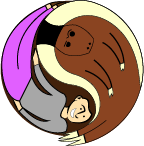The Short of It:
To unite the world, unite the self.

22. the increase of humility.
“[Those] that [humble themselves] shall be preserved entire. “[Those] that [bend themselves] shall be straightened. “[Those] that [are] low shall be filled. “[Those] that [are] worn out shall be renewed. “[Those] that [are] diminished shall succeed. “[Those] that [are] increased shall be misled.”
Therefore the sage embraces Unity, and is a pattern for all the world. [They are] not self-displaying, and, therefore, [they shine]. [They are] not self-approving, and, therefore, [they are] distinguished. [They are] not self-praising, and, therefore, [they have] merit. [They are] not self-exalting, and, therefore, [they stand] high. And inasmuch as [they do] not strive, no one in all the world strives with [them].
That ancient saying, “[those] that [humble themselves] shall be preserved entire.” Oh, it is no vain utterance! Verily, [they] shall be returned home entire (to [their] origin.)
22. ‘the increase granted to Humility.’
22.1 The partial becomes complete; the crooked, straight; the empty, full; the worn out, new. [Those] whose (desires) are few [get] them; [Those] whose (desires) are many [go] astray.
22.2 Therefore, the sage holds in [their] embrace the one thing (of humility), and manifests it to all the world. [They are] free from self-display, and therefore [they shine]; from self-assertion, and therefore [they are] distinguished; from self-boasting, and therefore [their merits are] acknowledged; from self-complacency, and therefore [they acquire] superiority. It is because [they are] thus free from striving that therefore no one in the world is able to strive with [them].
22.3 That saying of the ancients that ‘the partial becomes complete’ was not vainly spoken: -all real completion is comprehended under it.
22. humility’s increase.
22.1
“The crooked shall be straight, Crushed ones recuperate, The empty find their fill. The worn with strength shall thrill; Who little have receive, And who have much will grieve.”
22.2 Therefore
The holy [person] embraces unity and becomes for all the world a model.
Not self-displaying [they are] enlightened; Not self-approving [they are] distinguished; Not self-asserting [they acquire] merit; Not self-seeking [they] gaineth life.
Since [they do] not quarrel, therefore no one in the world can quarrel with [them].
22.3 The saying of the ancients: “The crooked shall be straight,” is it in any way vainly spoken? Verily, they will be straightened and return home.

The Long of It:
The sage character in the Tao Te Ching serves as example for the rest of us on how to get the most out of life. Over the course of the book, Lao Tsu builds a comprehensive picture of who that person might be. Chapter 22 brings a lot of those qualities together. Let’s review them:
In Chapter 3 the sage is politically powerful, reserved in words but determined in uniting the people.
In Chapter 5 the sage has no delusions about the permanence of the Universe, and guards their actions carefully.
In Chapter 7 the sage for the first time appears weak, supplanting their interests with the interests of others. However, combined with Chapters 3 and 5, makes for a well-rounded sage.
In Chapter 12 the sage again seems proactive and powerful, shielding their internal selves from too much external stimuli.
In Chapter 22 the sage is beyond powerful, the Universe at their command. But only because they are looking in the other direction. While everyone is busy pulling and pushing at the Universe, the sage holds tight to the center.
Extra Credit:
So what does a sage look like by Chapter 22? Primarily, they have the willpower to resist over-acting (Chaps 3 and 5). This is tempered by a strong sense to help everyone (Chap 7).
In Chapter 22 the sage glows with the raw understanding everything entails its opposite. As a result, this knowledge frees them from the conditions that drive most behavior (recognition, fame, merit, long-life, success). These are temporary and fickle goals that often flip-flop. The sage sees beyond these to the whole. So when they do finally act, it’s with complete disregard for their own gain. As a result, even when they fail, they succeed.
-TB
